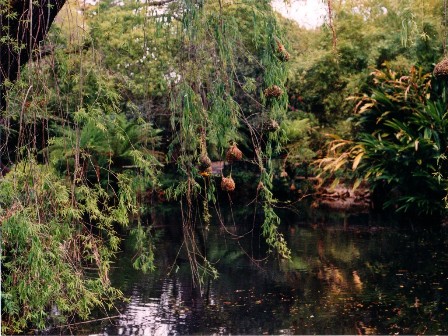 WeaveResearch Unit
WeaveResearch Unit
 WeaveResearch Unit
WeaveResearch Unit |
Weavers of the World |
| Home | Site map | Weavers of the World | Weaver Watch | Weaver Research Unit |
| This project has been upgraded to PHOWN (Photos of Weaver Nests) |
Weaver Watch - Counting weaver nests to monitor weaver colonies | ||
Monitoring weaver colonies anywhere in the world
Download form
Download latest guidelines
The main aim of this project is mainly to monitor long-term changes in individual weaver bird colonies. The data can also be used to look at colony changes within a breeding season and other breeding information like nest site choice, extent of mixed species colonies, and distribution of weaver colonies.
You can participate if you have a weaver colony in your garden, at work or another site that you regularly visit. You can also participate whenever you are on holiday or visit public areas (eg nature reserves) that may be visited by other birders participating in this project.
Weavers are found through much of Africa, southern Asia, and many Indian Ocean islands. Weavers have also been introduced to some other parts of the world. Any weaver colony that is not captive from anywhere in the world can be registered in this project.
This is a test phase, where data will start to be collected. If the project proceeds well, the results will be placed on the web in 2008 (all previous participants will be informed) in a searchable format, similar to the virtual museums at the ADU.
This project developed from monitoring Weaver colonies on the Cape Peninsula
To take part in this project, there are 3 steps to follow:
1. Find an active weaver colony!
You can participate if you have a weaver colony in your garden, at work or another site that you regularly visit. You can also participate whenever you are on holiday or visit public areas (eg nature reserves) that are likely to be visited by other birders participating in this project.
2. Download the form above and start filling it in.
When you first send an email, you will receive a Colony reference number which you need to use for Colony updates
3. Keep sending colony updates by counting the nests in the colony
I monitored a Cape Weaver colony at the Arderne Public Gardens, Claremont, Cape Town, over several years. This colony reduced in size annually and eventually became extinct (Oschadleus HD. 2006. Gradual extinction of Cape Weaver colony in Claremont. Promerops 265:11).
| Year | 1986 | 1992 | 1998 | 1999 | 2000 | 2001 | 2002 | 2003 | 2005 |
| Max. nests | 68 | >16 | >12 | 8 | 9 | 3 | 0 | 0 | 0 |

